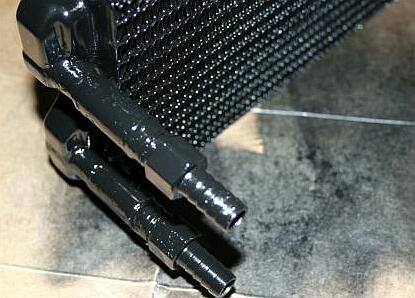DIY Water Cooling 101
Radiator
With all of the systems components transferring heat to the coolant, it is necessary to remove the heat from the loop. The most common way to accomplish this is to dispel the heat into the air by using a radiator. A radiator is simply a box with densely packed metal fins that can be placed either inside or outside the system's case. Coolant flowing through the radiator transfers its heat to the fins, which in turn transfer the heat to the moving air. More elaborate techniques exist, but for most systems a single radiator will cool the system just fine.
Since a computer's cooling loop is based on the same principles of an automobile engine's, it's no surprise that the cheapest and most efficient route is to take a part straight from a car. However, using a standard automobile radiator would be practically impossible due to the large size and flow requirements. Instead, enthusiasts use what is called a heater core. The most popular heater cores for water cooling are those from the 1984 Chevrolet Chevette and 1977 Pontiac Bonneville, due to their perfect sizes for full tower cases. The Chevette core has the correct surface area for a single 120 mm fan, while the Bonneville core is large enough to accommodate two. These can be purchased at most auto repair stores for between $20 and $30.
Before you can drop one of these heater cores into your computer, however, some slight modification is needed to use them in the loop. The most significant change required is to modify the fittings on the core. Simply cut the pipes leading from the stock core and replace them with new hose barbs purchased at a local hardware store. Make sure to clean the heater core first with a hose and a bucket of warm water, since they usually are fairly dirty out of the box.
Get Tom's Hardware's best news and in-depth reviews, straight to your inbox.
-
bigdogk9 check out a company called (asetek) best water cooler systems i have ever seen or used.Reply

